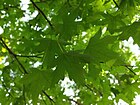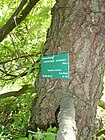Note: This is a project under development. The articles on this wiki are just being initiated and broadly incomplete. You can Help creating new pages.
Difference between revisions of "Liquidambar orientalis"
| Line 1: | Line 1: | ||
| − | + | [[File:Liquidambar orientalis arboretum Breuil 1.jpg|thumb|right]] | |
| + | '''Liquidambar orientalis''' is a deciduous tree that can grow up to 10.00 metres tall. It is harvested from the wild for local use as a food, medicine and source of materials. | ||
==Uses== | ==Uses== | ||
| − | {{Uses|}}, {{Uses|}}, {{Uses|}}, {{Uses|}}, {{Uses|}}, {{Uses|}}, {{Uses|}}, {{Uses|}}, {{Uses|}}, {{Uses| | + | {{Uses|Cough}}, {{Uses|Strokes}}, {{Uses|Infantile convulsions}}, {{Uses|Coma}}, {{Uses|Heart disease}}, {{Uses|Pruritis}}, {{Uses|Cancer}}, {{Uses|Scabies}}, {{Uses|Wounds}}, {{Uses|Ulcers}}.<ref name="Uses"/> |
==Parts Used== | ==Parts Used== | ||
| − | {{Parts Used|}}, {{Parts Used| | + | {{Parts Used|Leaves}}, {{Parts Used|Fruits}}, {{Parts Used|Bark}}, {{Parts Used|Roots}}. |
==Chemical Composition== | ==Chemical Composition== | ||
| Line 16: | Line 17: | ||
===Dravya=== | ===Dravya=== | ||
===Rasa=== | ===Rasa=== | ||
| − | |||
===Guna=== | ===Guna=== | ||
| Line 29: | Line 29: | ||
==Habit== | ==Habit== | ||
| − | {{Habit|}} | + | {{Habit|Deciduous tree}} |
==Identification== | ==Identification== | ||
| Line 48: | Line 48: | ||
==Mode of Propagation== | ==Mode of Propagation== | ||
| − | {{Propagation|}} | + | {{Propagation|Seeds}}, {{Propagation|Cuttings of half-ripe wood}}, {{Propagation|Suckers in early spring}}. |
==How to plant/cultivate== | ==How to plant/cultivate== | ||
| − | <ref name="How to plant/cultivate"/> | + | Prefers a moist but not swampy loam in a sheltered position. Prefers a neutral to acid soil. Grows poorly on shallow soils overlying chalk.<ref name="How to plant/cultivate"/> |
==Commonly seen growing in areas== | ==Commonly seen growing in areas== | ||
| − | {{Commonly seen|}}, {{Commonly seen|}}, {{Commonly seen| | + | {{Commonly seen|Flood plains}}, {{Commonly seen|Marshy places}}, {{Commonly seen|Valley sides near streams}}. |
==Photo Gallery== | ==Photo Gallery== | ||
<gallery class="left" caption="" widths="140px" heights="140px"> | <gallery class="left" caption="" widths="140px" heights="140px"> | ||
| − | + | Liquidambar orientalis 13.jpg | |
| + | Liquidambar orientalis and French Greenhouse, c. 1883-1884 - Orto botanico - Rome, Italy - DSC09843.jpg | ||
| + | Liquidambar orientalis and French Greenhouse, c. 1883-1884 - Orto botanico - Rome, Italy - DSC09851.jpg | ||
| + | Liquidambar orientalis arboretum Breuil 1.jpg | ||
| + | Liquidambar orientalis arboretum Breuil 2.jpg | ||
| + | Liquidambar orientalis arboretum Breuil 3.jpg | ||
</gallery> | </gallery> | ||
==References== | ==References== | ||
<references> | <references> | ||
| − | + | <ref name="chemical composition">[Chemistry]</ref> | |
| − | <ref name="chemical composition">[ | + | <ref name="Leaf">[Morphology]</ref> |
| − | + | <ref name="How to plant/cultivate">[http://temperate.theferns.info/plant/Liquidambar+orientalis Cultivation]</ref> | |
| − | <ref name="Leaf">[ | ||
| − | |||
| − | <ref name="How to plant/cultivate">[ | ||
<ref name="Uses">Indian Medicinal Plants by C.P.Khare</ref> | <ref name="Uses">Indian Medicinal Plants by C.P.Khare</ref> | ||
</references> | </references> | ||
==External Links== | ==External Links== | ||
| − | * [ ] | + | * [http://www.missouribotanicalgarden.org/PlantFinder/PlantFinderDetails.aspx?taxonid=291500 Liquidambar orientalis on missouribotanicalgarden.org] |
| − | * [ ] | + | * [https://www.oatext.com/properties-and-usage-of-liquidambar-orientalis.php Liquidambar orientalis on oatext.com] |
| − | * [ ] | + | * [https://pfaf.org/user/Plant.aspx?LatinName=Liquidambar+orientalis Liquidambar orientalis on pfaf.org] |
[[Category:Herbs]] | [[Category:Herbs]] | ||
[[Category:Pages without herbs images]] | [[Category:Pages without herbs images]] | ||
Latest revision as of 13:15, 4 June 2020
Liquidambar orientalis is a deciduous tree that can grow up to 10.00 metres tall. It is harvested from the wild for local use as a food, medicine and source of materials.
Contents
- 1 Uses
- 2 Parts Used
- 3 Chemical Composition
- 4 Common names
- 5 Properties
- 6 Habit
- 7 Identification
- 8 List of Ayurvedic medicine in which the herb is used
- 9 Where to get the saplings
- 10 Mode of Propagation
- 11 How to plant/cultivate
- 12 Commonly seen growing in areas
- 13 Photo Gallery
- 14 References
- 15 External Links
Uses
Cough, Strokes, Infantile convulsions, Coma, Heart disease, Pruritis, Cancer, Scabies, Wounds, Ulcers.[1]
Parts Used
Chemical Composition
Common names
| Language | Common name |
|---|---|
| Kannada | |
| Hindi | |
| Malayalam | |
| Tamil | |
| Telugu | |
| Marathi | |
| Gujarathi | |
| Punjabi | |
| Kashmiri | |
| Sanskrit | |
| English |
Properties
Reference: Dravya - Substance, Rasa - Taste, Guna - Qualities, Veerya - Potency, Vipaka - Post-digesion effect, Karma - Pharmacological activity, Prabhava - Therepeutics.
Dravya
Rasa
Guna
Veerya
Vipaka
Karma
Prabhava
Habit
Identification
Leaf
| Kind | Shape | Feature |
|---|---|---|
Flower
| Type | Size | Color and composition | Stamen | More information |
|---|---|---|---|---|
| {{{5}}} |
Fruit
| Type | Size | Mass | Appearance | Seeds | More information |
|---|---|---|---|---|---|
Other features
List of Ayurvedic medicine in which the herb is used
Where to get the saplings
Mode of Propagation
Seeds, Cuttings of half-ripe wood, Suckers in early spring.
How to plant/cultivate
Prefers a moist but not swampy loam in a sheltered position. Prefers a neutral to acid soil. Grows poorly on shallow soils overlying chalk.[4]
Commonly seen growing in areas
Flood plains, Marshy places, Valley sides near streams.
Photo Gallery
References
- ↑ Indian Medicinal Plants by C.P.Khare
- ↑ [Chemistry]
- ↑ [Morphology]
- ↑ Cultivation
External Links
- Ayurvedic Herbs known to be helpful to treat Cough
- Ayurvedic Herbs known to be helpful to treat Strokes
- Ayurvedic Herbs known to be helpful to treat Infantile convulsions
- Ayurvedic Herbs known to be helpful to treat Coma
- Ayurvedic Herbs known to be helpful to treat Heart disease
- Ayurvedic Herbs known to be helpful to treat Pruritis
- Ayurvedic Herbs known to be helpful to treat Cancer
- Ayurvedic Herbs known to be helpful to treat Scabies
- Ayurvedic Herbs known to be helpful to treat Wounds
- Ayurvedic Herbs known to be helpful to treat Ulcers
- Herbs with Leaves used in medicine
- Herbs with Fruits used in medicine
- Herbs with Bark used in medicine
- Herbs with Roots used in medicine
- Habit - Deciduous tree
- Index of Plants which can be propagated by Seeds
- Index of Plants which can be propagated by Cuttings of half-ripe wood
- Index of Plants which can be propagated by Suckers in early spring
- Herbs that are commonly seen in the region of Flood plains
- Herbs that are commonly seen in the region of Marshy places
- Herbs that are commonly seen in the region of Valley sides near streams
- Herbs
- Pages without herbs images






